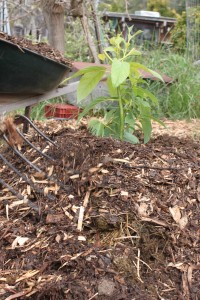Pre-arrival:
Prepare a mound 2 feet high and 6 feet wide made of a mixture of sand, native topsoil and if necessary, some completely composted organic material. The idea is to build a well draining mound. Were not talking about a $150 hole laced with Kelp and B-12, green sand, spirulina, time release osmocoted, pelletized organic magic grow powder. We just want to raise the tree roots up above the normal grade, reducing drainage problems during periods of heavy rain. Fertility will leach down from the composting mulch and manure/fertilizer you pile on the surface. So just do what you need to achieve drainage, not more: if your soil is naturally sandy and light, for instance, don’t bother adding more sand. No fertilizer, fresh compost, or uncomposted plant material in the mound. Dig a hole 2 feet deep into the mound.
Upon arrival:
Open the packing box out of the direct sun.
Water the tree immediately.
Place the tree in its grow-bag directly into the hole. Set a 3-4 foot stick of bamboo, 1/2″ thick in the ground next to the root ball to act as a support for the baby tree.
Gently slice through the side and bottom of the growbag and peel off. Fill the hole until the soil is level with the top of the root ball. Leave a slight basin (about 18” across) at the top of the mound to water into.
Water the mound thoroughly and settle the tree in place.
Cover the entire mound with 6-12 inches of mulch, except for the basin around the tree, which should remain only lightly mulched.
Spread up to 15 pounds of gypsum (sold at most nurseries) over the mulch and water it in.
Sunburn is a potential problem. Paint exposed bark with diluted white latex paint or kaolin clay (Surround). If your tree has few leaves, put a tomato cage around the tree and drape a piece of light row crop cover over the cage to filter the sunlight until more leaves emerge to provide cover.
Water thoroughly twice per week until the Fall rains take-over. The tree should be kept damp but not saturated. The tree should never be allowed to dry out completely.
At planting time, apply a slow release organic fertilizer like horse manure (either fresh or aged), alfalfa meal, or feather meal. Composted cow, chicken, rabbit or goat manure can be fine in moderation. Horse manure can be applied at the rate of at least one wheelbarrow load per every three feet in tree height. Repeat applications every month or two until the end of summer. Stop fertilizing by November as the tree can’t absorb much in cold soil.
Avocados enjoy a layer of leaf debris shading their roots; don’t clean under the trees: let leaves accumulate, and add a few additional inches of mulch each year. Allow the mulch to smother weeds: the avocado mound should remain weed free.
Photo Essay: How to plant an avocado tree.
Ready to plant with wheelbarrows full of mulch and compost.
Move soil to create a mound about 18 high and 4-5 feet across.
Dig a hole in the top of the mound that will be large enough to fit your tree’s root ball.
Place plant in the hole. If in a plastic pot. tip it carefully into your (or a friend’s) hand and place it gently in the hole. If necessary to preserve the roots, sacrifice the pot by slitting down the side with a utility knife.
Gently remove the pot from around the tree.
The soil level of the plant should be even with the top of the mound.


Now cover your mound with aged manure or compost.
Add a thick layer of mulch on top of the compost.
Water it well after planting, and weekly thereafter (more in hot weather).
Shade the tree (we are using row cover in the photo) and if you like, paint the trunk with diluted (50/50) latex paint to protect it until new growth arrives to protect the stems from sunburn.













